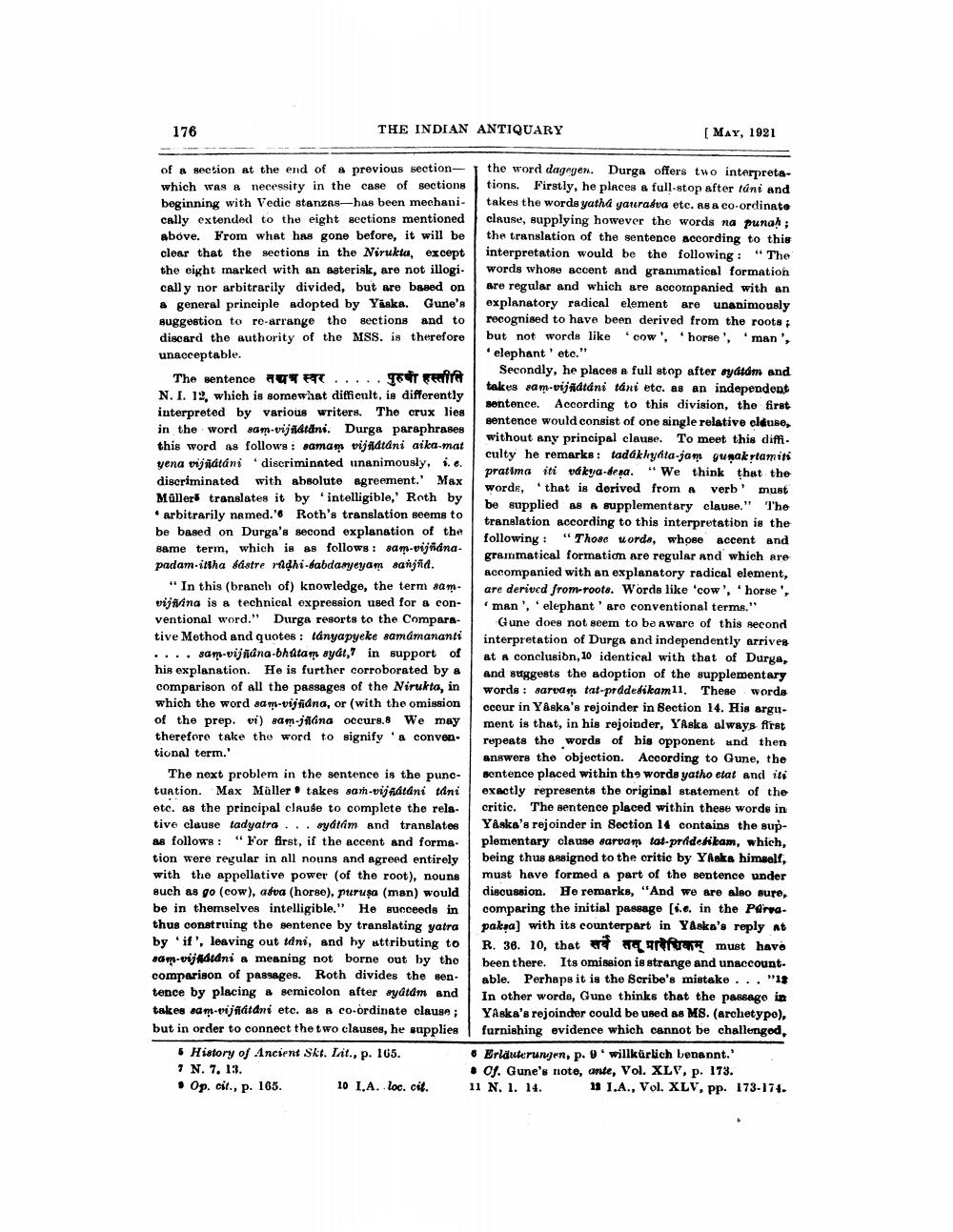________________
176
THE INDIAN ANTIQUARY
[ MAY, 1921
of a section at the end of a previous section- | the word dagegen. Durga offers two interpretawhich was a necessity in the case of sections tions. Firstly, he places a full stop after tůni and beginning with Vedic stanzas-has been mechani- takes the words yatha yauradva etc. As a co-ordinate cally extended to the eight sections mentioned clause, supplying however the words na puna; above. From what has gone before, it will be the translation of the sentence according to this clear that the sections in the Nirukta, except interpretation would be the following: "The the eight marked with an asterisk, are not illogi. words whose accent and grammatical formation cally nor arbitrarily divided, but are based on are regular and which are accompanied with an a general principle adopted by Yiska. Gune's explanatory radical element are unanimously suggestion to re-arrange the sections and to recognised to have been derived from the roots : discard the authority of the MSS. is therefore but not words like "cow', 'horse','man', unacceptable.
elephant' etc."
Secondly, he places a full stop after ryštám and The sentence 99 ..... Toreira
takes sam-viAdidni tani etc. as an independent N. I. 12. which is somewhat difficult, is differently
sentence. According to this division, the first interpreted by various writers. The crux lies
sentence would consist of one single relative olduse, in the word sam-vijnatani. Durga paraphrases
without any principal clause. To meet this diffi. this word as follows: samam vijfdtani aika-mat
culty he remarks: tadakhyata-jam gunak rtamiti yena vijfdtáni discriminated unanimously, i.e.
pratima iti vákya-dena. "We think that the discriminated with absolute agreement.' Max
words, that is derived from verb' must Müllers translates it by 'intelligible,' Roth by
be supplied as a supplementary clause." The • arbitrarily named.'s Roth's translation seems to
translation according to this interpretation is the be based on Durga's second explanation of the
following: "Those uorde, whose accent and same term, which is as follows: sam-vijfdna
grammatical formation are regular and which are padam-ittha sústre ridhi-tabdasyeyam sanjña.
accompanied with an explanatory radical element, "In this branch of) knowledge, the term sam.
are derived from-roote. Words like 'cow', 'horse, vijana is a technical expression used for a con
'man', 'elephant' are conventional terms." ventional word." Durga resorts to the Compara- Gune does not seem to be aware of this second tive Method and quotes : lányapyeke samdmananti interpretation of Durga and independently arrives .... sam-vijnana-bhatam ayát,7 in support of at a conclusion, 10 identical with that of Durga, his explanation. He is further corroborated by a
and suggests the adoption of the supplementary comparison of all the passages of the Nirukta, in
words: saruam tat-prddedikam11. These words which the word sam-vijfidna, or (with the omission cccur in Y Aska's rejoinder in Section 14. His arguof the prep. vi) sam-jfiana occurs. We may ment is that, in his rejoinder, Yaska always ffrat therefore take the word to signify a conven
repeats the words of his opponent and then tional term.'
answers the objection. According to Gune, the The next problem in the sentence is the punc- sontence placed within the words yatho etat and its tuation. Max Müller takes sam-vijfidtani tani exactly represents the original statement of the etc. as the principal clause to complete the rela- critic. The sentence placed within these words in tive clause tadyatra ... syatim and translates Yaska's rejoinder in Section 14 contains the supas follows: "For first, if the accent and forma. plementary clause sarvam tat-pradedikam, which, tion were regular in all nouns and agreed entirely being thus assigned to the critic by Yaaks himself, with the appellative power (of the root), nouns
must have formed a part of the sentence under such as go (cow), afva (horse), purusa (man) would discussion. He remarks, "And we are also sure, be in themselves intelligible." He succeeds in comparing the initial passage (iein the Perua. thus construing the sentence by translating yatra paksa) with its counterpart in Yaska's reply at by 'if', leaving out tani, and hy attributing to R. 36. 10, that Tarrat must havo sam-vijaidni a meaning not borne out by the been there. Its omission is strange and unaccount. comparison of passages. Roth divides the sen.
able. Perhaps it is the Scribe's mistake ... "13 tence by placing a semicolon after sydtdm and
In other words, Gune thinks that the passage in takes sam-vijfiatani etc. as a co-ordinate clause; YAska's rejoinder could be used as M8. (archetypo), but in order to connect the two clauses, he supplies furnishing evidence which cannot be challenged, • History of Ancient Skt. Lit., p. 105.
6 Erläuterungen, p. 9' willkürlich benannt. 7 N. 7. 13.
• Oj. Gune's riote, ante, Vol. XLV, p. 173. • Op. cit., p. 165. 10 I.A. loc. cit. 11 N. 1. 14. 1 1.A., Vol. XLV, pp. 173-174.




